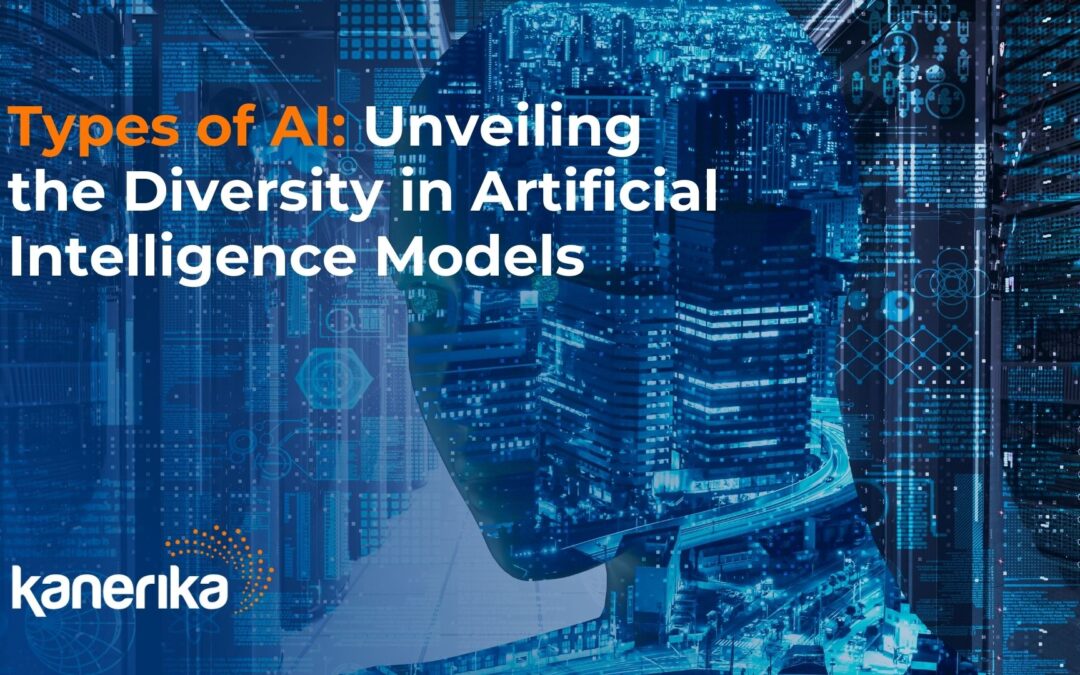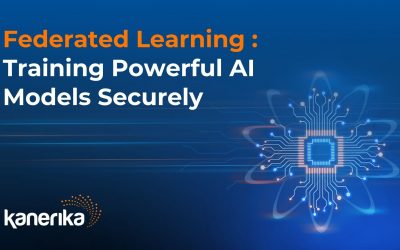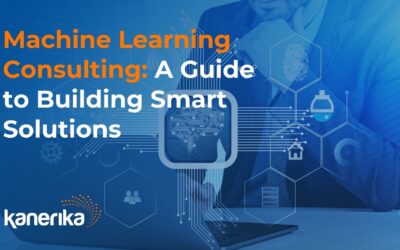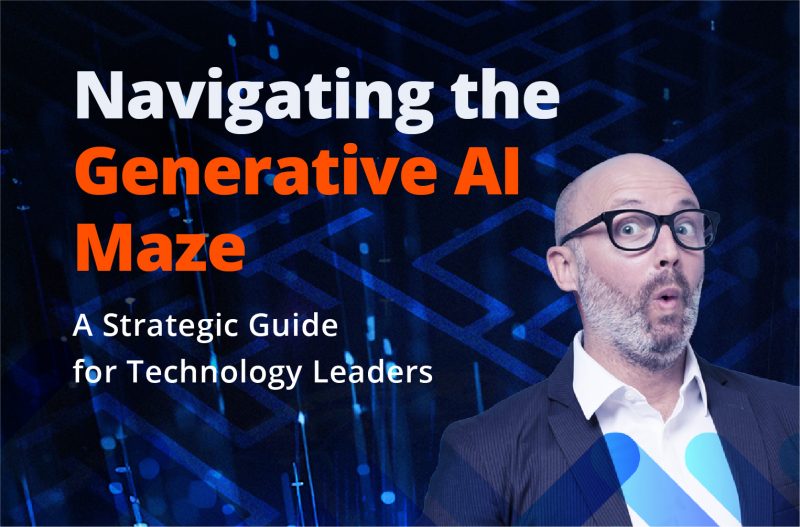Did you know, by 2030, AI is expected to contribute over $15.7 trillion to the global economy? This number highlights the immense potential and economic impact of AI. Chances are, you’ve interacted with some form of AI in your daily life without even realizing it. From surprisingly accurate recommendations on your favorite streaming service to the AI-powered chatbots handling customer inquiries, Artificial Intelligence (AI) is changing the way businesses operate. But with so many different types of AI out there, it’s crucial to understand their capabilities to leverage them effectively
In today’s tech-driven, fast-paced world, staying competitive means embracing innovation. AI is a powerful tool that modern businesses can leverage to gain a significant edge. AI’s role in modernizing businesses is undeniable. As companies around the globe strive for efficiency and innovation, the adoption of various types of AI technologies becomes not just beneficial but essential.
What is Artificial Intelligence?
Artificial intelligence (AI) is a broad field of computer science that aims to create intelligent machines capable of mimicking human cognitive functions like learning, problem-solving, and decision-making. In simpler terms, it’s about training computers to perform tasks that traditionally required human intelligence. Below are some key features of AI:
- Intelligence: AI systems exhibit intelligent behavior by analyzing data, identifying patterns, and adapting their actions accordingly.
- Learning: AI can learn from experience, either through pre-programmed data or by interacting with the environment. This allows them to improve their performance over time. In line with enhancing interactive environments, tools leveraging AI to convert text into engaging videos represent a perfect blend of creativity and technology, making it easier for businesses to produce content that resonates with their audience.
- Problem-solving: AI systems can analyze complex situations, identify problems, and develop solutions.
- Decision-making: Based on the analysis of data and learned patterns, AI can make informed decisions.
Case Study Video: Revolutionizing Predictive Engine with AI in Logistics
See how Kanerika helped optimize the logistics operations of a prominent logistics company by developing an AI/ML-based prediction engine.
Types of AI: Based on Functionality
1. Reactive Machines
Reactive machines operate on a very basic principle of AI technology. They are designed to respond to a specific set or sequence of inputs with a predictable output, making them reliable for tasks requiring consistency without the need for past learning or data storage capabilities. This type of AI is the most similar to classical computing systems where responses are pre-programmed, and the systems lack the ability to learn from past experiences or improve over time.
Key Characteristics
- No Memory Function: Reactive machines do not store memories or past experiences to influence future decisions.
- Specific Tasks: They are designed to perform narrowly defined tasks and cannot go beyond the scenarios they are programmed for.
- High Consistency: The outputs are highly consistent when presented with the same input, as there is no variation in behavior over time.
Use Cases
- Chess Programs (IBM’s Deep Blue): Reactive machines like Deep Blue can determine the best chess moves based on the current state of the game without considering previous games. This allows them to be highly effective in structured environments with clear rules.
- Basic Customer Support Bots: These bots handle customer queries by providing standardized answers to frequently asked questions. They respond based on a given set of rules and do not adapt based on past interactions.
- Process Automation in Manufacturing: In industrial settings, reactive machines perform specific, repetitive tasks such as assembling components in a factory line with precision and without fatigue, ensuring consistent product quality.
2. Limited Memory Machines
Limited memory machines can look into the past. More advanced than purely reactive machines, these AI systems can use historical data temporarily to make decisions. This is seen in applications like personal assistants that learn from user interactions or autonomous vehicles which adjust their actions based on recent observations of the environment.
Key Characteristics
- Temporary Data Storage: They can store recent information temporarily to make decisions or improve their responses.
- Learning Over Time: These machines learn from recent past experiences to enhance their decision-making process.
- Dynamic Adjustments: They can adjust their actions based on the analysis of incoming data over a short period.
Use Cases
- Autonomous Vehicles: Limited memory machines in autonomous vehicles use recent driving data to make decisions such as changing lanes or adjusting speed based on the movements of surrounding vehicles. This memory allows for smoother and safer driving experiences.
- Personalized Content Recommendations: Streaming services like Netflix use limited memory AI to recommend shows and movies based on recent viewing history, improving user experience by providing tailored content suggestions.
- Predictive Text and Auto-Correction: Smartphone keyboards use this type of AI to predict and correct text as you type. The AI learns from your recent typing habits to offer better word predictions and corrections. Moreover, the application of AI extends to making videos more accessible and engaging through adding subtitles seamlessly, improving comprehension and reach to a broader audience.
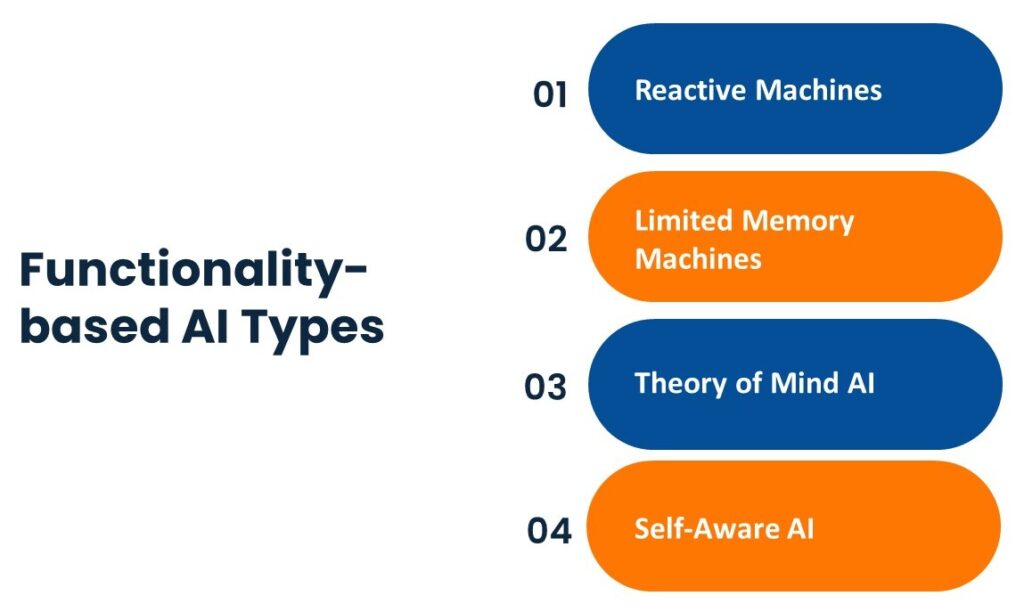
3. Theory of Mind AI
Theory of Mind AI remains largely theoretical and is the frontier of artificial intelligence where machines would be able to fully understand human emotions, beliefs, and intentions to the extent that they can engage in social interaction. This kind of AI would not only comprehend but also predict human emotions and potentially engage in complex social interactions.
Key Characteristics
- Emotional Intelligence: Can understand and react to human emotions.
- Social Perception: Capable of interpreting social cues and adapting responses accordingly.
- Interaction Skills: Designed to engage in human-like interactions, understanding verbal and non-verbal communication.
Use Cases
- Advanced Social Robots: Robots equipped with Theory of Mind AI could serve in roles that require emotional sensitivity, such as caretakers for older people or companions for those with social disorders, providing interactions that consider the emotional state of the person.
- Enhanced User Interfaces: Devices and applications that adapt their responses based on the user’s emotional state, potentially changing their approach during interactions to fit the mood and needs of the user.
- Customer Service and Support: AI in this role could dynamically adjust its tactics based on the customer’s mood and tone during interactions, potentially leading to more effective and satisfying customer service.
4. Self-Aware AI
Self-aware AI represents the pinnacle of AI development, embodying systems that would not only engage in intelligent decision-making and learning but would also possess awareness of their own existence. This type of AI would be capable of understanding and formulating concepts about itself, having a consciousness akin to human-like self-awareness. This remains a theoretical concept as of now, with no practical implementations yet achieved.
Key Characteristics
- Self-consciousness: Ability to recognize itself as an entity separate from others and understand its actions.
- Meta-cognition: Understands its own thought processes and can adjust strategies by self-assessment.
- Advanced Adaptability: Can adapt its functioning based on self-diagnosis and awareness.
Use Cases
- Complex Decision-Making: Self-aware AI could handle decisions that require an understanding of multiple variables and contexts, potentially leading to roles in strategic planning and high-level problem-solving.
- Personalized Learning and Adaptation: Such AI could personalize learning experiences by understanding and adjusting to its own learning pace and methods, enhancing educational tools.
- Advanced Negotiation Systems: These systems could perform complex negotiations by understanding and manipulating their emotional expressions in a way.
Types of AI: Based on Capabilities
1. Narrow AI (ANI)
Narrow AI (Artificial Narrow Intelligence) is specialized in one area or task, performing specific operations without the general cognitive abilities of human intelligence. It operates within predefined scenarios and is designed to handle single or limited tasks.
Key Characteristics
- High Specialization: Excel in specific tasks they are designed for, such as image recognition or language processing.
- No Generalization: Incapable of applying their learned experiences to unfamiliar tasks outside their predefined scope.
- Dependence on Human Programming: Requires detailed programming and cannot make decisions beyond its coded capacity.
Use Cases
- Speech Recognition Systems: Tools like Siri and Alexa that recognize and process human speech within a limited domain.
- Facial Recognition: Used in security systems to identify individuals in a crowd or for unlocking devices.
- Automated Customer Service: Chatbots and virtual assistants that handle customer inquiries and provide information based on a scripted set of responses.
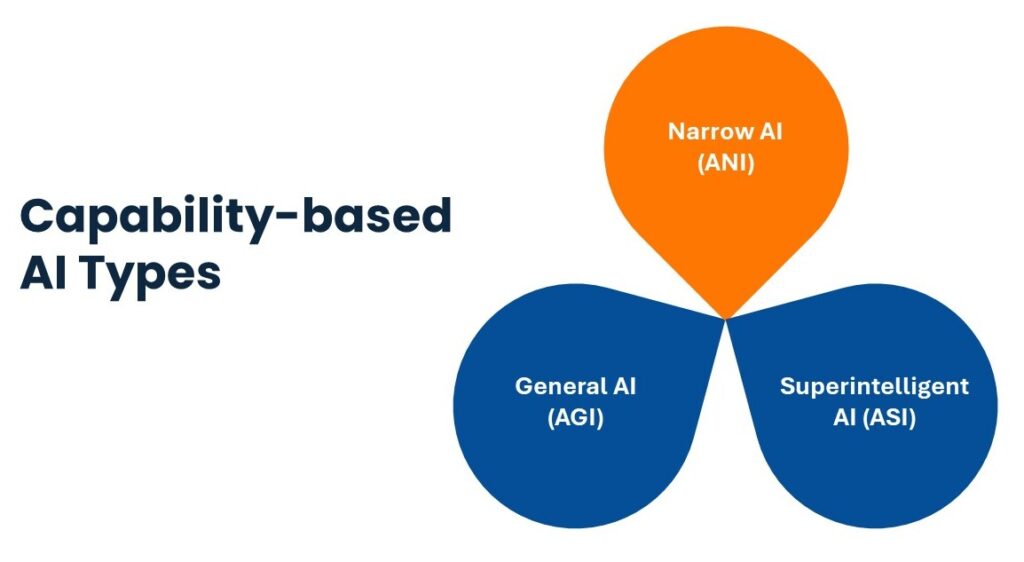
2. General AI (AGI)
Artificial General Intelligence (AGI) refers to AI systems that possess the ability to understand, learn, and apply intelligence across a broad range of tasks, mimicking human cognitive abilities. This type of AI can perform any intellectual task that a human being can.
Key Characteristics
- Adaptive Learning: Capable of learning from experiences and applying this learning to solve new and diverse problems.
- Contextual Understanding: Understands complex contexts and nuances of different environments, much like a human.
- Decision-Making Abilities: Can make autonomous decisions based on learned information and sensory inputs.
Use Cases
- Comprehensive Personal Assistants: Systems that manage more than just routine tasks; they can make decisions and understand requests in a human-like manner.
- Advanced Healthcare Providers: Robots or systems capable of diagnosing diseases and providing healthcare advice based on a broad understanding of medicine and patient history.
- Robotics: Machines that can perform a variety of tasks in unpredictable environments, such as household robots that adapt to individual family needs.
3. Superintelligent AI
Superintelligent AI is a hypothetical form of AI that not only mimics but also surpasses human intelligence in all aspects, including creativity, problem-solving, and emotional intelligence. It is theorized to be capable of self-improvement, potentially leading to rapid advancements beyond human control.
Key Characteristics
- Self-Improvement: Ability to autonomously improve its own algorithms and capabilities without human intervention.
- Superior Decision-Making: Possesses decision-making capabilities that exceed the most intelligent and experienced humans in practically every field.
- Autonomous Learning: Can learn from its environment and experiences at an accelerated rate, with minimal or no human input.
Use Cases
- Global Management Systems: Could manage complex systems like national or global economies, optimizing resource distribution and economic stability.
- Scientific Research: Capable of leading scientific research and innovation, solving complex scientific problems faster than human-led teams.
- Strategic Defense Systems: Could control and manage national defense systems with capabilities that exceed human strategic thinking, providing responses to threats with superhuman foresight and efficiency.
Our AI Success Story: Revolutionizing Operational Efficiency with AI Solutions
Learn how a renowned skincare firm streamlined their business operations and enhanced their customer experiences with KanerIka’s AI expertise
Types of AI Based on Learning Abilities
1. Machine Learning (ML)
Machine Learning is a subset of artificial intelligence focused on building systems that learn from data, identify patterns, and make decisions with minimal human intervention.
Key Characteristics
- Pattern Recognition: Machine learning algorithms excel in identifying patterns and correlations in large datasets, a fundamental trait for tasks like fraud detection or market analysis.
- Adaptability: These systems improve over time autonomously by learning from their successes and mistakes in previous computations.
- Data Dependency: The performance and accuracy of machine learning models are heavily dependent on the quality and quantity of data they are trained on.
Use Cases
- Predictive Analytics: Used in various industries for forecasting market trends, customer behavior, and potential risks.
- Image Recognition: Essential in technologies like automated photo tagging in social media or medical imaging diagnostics.
- Natural Language Processing (NLP): Powers applications such as speech recognition, translation services, and chatbots.
2. Deep Learning
Deep Learning is a specialized subset of machine learning involving neural networks with three or more layers. These neural networks attempt to simulate human decision-making with layered nodes, or “neurons,” and can handle vast amounts of data.
Key Characteristics
- Hierarchical Feature Learning: Deep learning models learn to recognize patterns in layers, where each layer interprets different aspects of the data, from simple to complex patterns.
- High Resource Requirement: These models require substantial computational power and data, typically more so than traditional machine learning models.
- Automatic Feature Extraction: Unlike traditional machine learning, deep learning automates much of the feature extraction process, reducing the need for manual intervention.
Use Cases
- Autonomous Vehicles: Deep learning models process and interpret real-time data from vehicle sensors to make driving decisions.
- Voice Control Systems: Systems like Amazon Alexa and Google Home use deep learning for effective speech understanding and natural language interaction.
- Advanced Image Processing: Used extensively in real-time image and video recognition, supporting applications in security surveillance and content filtering.
3. Reinforcement Learning
Reinforcement Learning is a type of machine learning where an agent learns to make decisions by performing certain actions and receiving rewards or penalties based on those actions. It mimics the way humans learn through trial and error.
Key Characteristics
- Decision Process: The learning process is driven by the outcomes of sequential decisions, making it suitable for dynamic environments where conditions constantly change.
- Reward System: Learning is controlled by rewards systems, which incentivize the AI to make optimal decisions based on received feedback.
- Exploration vs. Exploitation: Reinforcement learning algorithms must balance between exploring new strategies and exploiting known strategies that work.
Use Cases
- Game Playing: Powers AI to master games like Go and chess, where the AI must evaluate countless potential moves and their long-term outcomes.
- Robot Navigation: Robots learn to navigate complex environments safely and efficiently, adjusting their paths based on interactive feedback.
- Personalized Recommendations: Online platforms use reinforcement learning to adjust their algorithms based on how users interact with different content, optimizing user engagement and satisfaction.
Ethical Considerations and Challenges of AI
1. Bias and Discrimination
AI systems perpetuate social imbalances if they are trained on biased data. For example, a hiring algorithm might favor resumes containing specific keywords, thereby potentially discriminating against particular groups of people. It is therefore important to develop varied datasets while continuously checking algorithms for bias.
2. Transparency and Explainability
Many AI systems, especially complex neural networks, lack transparency in their decision-making. This black box effect makes it difficult to understand why an AI came up with a certain conclusion, which in turn affects trust and accountability. In areas like healthcare or law enforcement, where human oversight and intervention are necessary, Generative AI models that humans can understand should be used alongside other solutions.
3. Privacy and Security
The amount of data needed for training AI raises privacy concerns. As artificial intelligence becomes deeply rooted in our lives, safeguarding individual privacy will become more important than ever before. There should also be strong protocols on data security and regulations that ensure responsible collection, storage, and use of data. Besides, AI systems themselves are vulnerable to hacking, potentially leading to security breaches and misuse.
4. Ethics of Autonomous Weapons
The development of autonomous weapons, often referred to as killer robots, poses grave risks. Machines making decisions about life or death raise ethical and legal questions. International collaboration and regulations are crucial to prevent an arms race in autonomous weapons.
Future of AI
1. Advancements in General AI
While current AI technologies excel in specific tasks (narrow AI), future advancements may lead towards more generalized forms of AI (AGI). These advancements could enable AI systems to perform a wide range of cognitive tasks just like humans, from solving complex problems to making decisions in dynamic and unfamiliar environments.
2. AI and IoT Convergence
The convergence of AI with the Internet of Things (IoT) promises to transform data analytics by enabling more efficient processing and interpretation of data from billions of devices. This could lead to smarter cities, enhanced industrial automation, and highly responsive service systems in real-time.
3. Autonomous Vehicles and Robotics
The development of fully autonomous vehicles and advanced robotics is likely to accelerate. This technology could transform logistics and transportation, as well as provide new solutions and assistive technologies for those with varying abilities.
4. Quantum AI
Quantum computing could potentially revolutionize AI by providing the computational power necessary to process complex problems much faster than current technologies. This could enhance AI’s abilities in areas such as cryptography, material science, and complex system simulation.
Step Into the Future with Kanerika’s Advanced AI Technologies
As a leader in the AI industry, Kanerika pushes the boundaries of innovation. As a top-ranked AI company, we deliver cutting-edge solutions designed to tackle complex business challenges and propel organizations forward. Our expertise in AI is not just about keeping pace with technological advancements; it’s about setting the pace.
By optimizing business operations and harnessing the full potential of AI, we ensure that your company not only meets industry standards but sets them. With a robust portfolio of successful AI projects, we are committed to delivering exceptional results that help our clients outperform their competitors and achieve business efficiency and growth.

